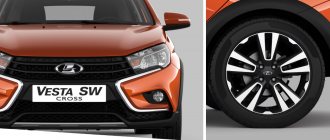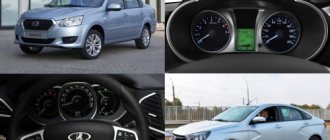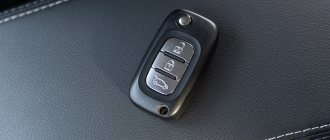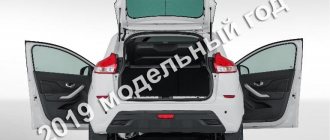Autoreview experts decided to find out whether the Lada XRAY can surpass the Lada Vesta SW Cross. The Chevrolet Niva SUV also took part in the big test. This is the last production all-wheel drive vehicle developed in Tolyatti twenty years ago. In a comparative review, we decided to show what AVTOVAZ could do then - and what it has come to now.
Specifications
| Lada Xray Cross | Lada Vesta SW Cross | Chevrolet Niva | |
| Price | 914,000 rub. | 884,000 rub. | 776,000 rub. |
| Issued from | 2018 | 2017 | 2002 |
| Motor and gearbox | |||
| Engine | petrol / 1774 cm³ | petrol / 1774 cm³ | petrol / 1690 cm³ |
| Power | 122 hp | 122 hp | 80 hp |
| Transmission | mechanical / 5 steps | mechanical / 5 steps | mechanical / 5 steps |
| Drive unit | front | front | full |
| Acceleration to hundreds | 10.3 seconds | 11.2 seconds | 19 seconds |
| Maximum speed | 179 km/h | 180 km/h | 140 km/h |
| Fuel consumption | 9.3 / 5.8 / 7.1 l/100km | 10.7 / 6.4 / 7.9 l/100km | 13.2 / 8.4 / 10.2 l/100km |
| Body | |||
| Ground clearance | 215 mm | 203 mm | 220 mm |
| Dimensions (length × width × height) | 4165 / 1764 / 1645 mm | 4424 / 1785 / 1532 mm | 4056 / 1800 / 1690 mm |
| Trunk volume | 361 l | 480 l | 320 l |
| Fuel tank volume | 50 l | 55 l | 58 l |
| Vehicle weight | 1250 kg | 1280 kg | 1410 kg |
| Safety | |||
| Anti-lock braking system (ABS) | There is | There is | There is |
| Stabilization system (ESP) | There is | There is | unavailable |
| Number of airbags | 2 | 4 | 2 |
| Driver airbag | There is | There is | There is |
| Front passenger airbag | There is | There is | There is |
| Front side airbags | unavailable | There is | unavailable |
Test results
Expert assessments were given based on a number of criteria.
Ergonomics
. Vesta provides good planting geometry. XRAY is worse, despite adjusting the steering wheel for reach and a new seat. Niva is about the same level, but unless you are above average height (the range of seat adjustments is limited). But visibility is better (huge mirrors, powerful headlights). Vesta is let down by wide pillars, and XRAY is let down by small mirrors.
Dynamics
. Vesta accelerates and turns more pleasantly than anyone else. The Niva is slow, but its connection to the gas pedal is much clearer than that of the more dynamic XRAY, which is uncomfortable to drive. Equal scores with the Niva for handling are associated only with the lack of a stabilization system on the Niva - the chassis itself is better tuned. In terms of cross-country ability, there is no equal to the Niva.
Ride comfort
. Despite the additional sound insulation of the Cross version, XRAY turned out to be noisier than Vesta due to the disgusting sound of the engine. Niva in the “civilian” version without a snorkel does not frighten with unnecessary noise at all permitted speeds and is noticeably superior to Crosses in terms of smoothness.
Comfort in the cabin
. Vesta is longer than the others and, as expected, wins over everyone in terms of rear space and trunk volume. And the compartment is well thought out. The Xray and Niva are all more modest, and the Chevrolet transformation is from the last century: to recline the backs of the rear seats, you first need to raise the pillows.
As a result, the total score was calculated, which determined the winner:
After the Lada Vesta model appeared on the horizon, many of those who intended to purchase a car opted for a new domestic sedan. However, this situation persisted only until the Lada X-Ray hatchback began to roll off the assembly line. This is where many potential buyers became confused, not knowing which model to give preference to. Should you buy a Vesta, tempted by the low cost and the familiar sedan body, or pay more and get a practical and powerful hatchback in return? This dilemma should not remain unanswered!
Lada X-Ray or Lada Vesta? The question is clearly not an easy one.
Maximum configuration
Vesta in the “Lux” acquired a 16-diameter casting, all the handles and mirrors are in body color, full power accessories, even rear parking sensors, an audio system with 6 speakers, heated windshields and door lighting when it is opened.
For comfort, the cabin now has air conditioning, climate control, rain and light sensors, a glove compartment with a cooling system, an armrest, an eyeglass case and a mirror in the visor.
How will Xray Vesta respond? It has fog lights at maximum speed, a retractable compartment under the passenger seat, a double floor in the trunk, a heated glove compartment and even enhanced tinting of the rear windows.
Body range of Vesta and X Ray
There is no need to talk about prestige in this case, since both models came off the assembly line of the same plant. And the buyers themselves still haven’t decided which one has more status. But the differences in terms of the body are much more significant.
Future station wagon from Lada Vesta.
So far, the Lada Vesta is sold as a sedan, but its significant expansion is being prepared - this will include a hatchback, a station wagon, a long-wheelbase version of the Lada Vesta Signature, and a pseudo-off-road Lada Vesta Cross. Therefore, soon new products from the Togliatti plant will fall like ripe apples!
Lada Vesta Cross car!
The Lada Xray acts exclusively as a hatchback (although many are persistently trying to present it as a crossover), and there can be no other option, excluding only the Lada XRAY Cross modification, which will soon appear on the market. However, apart from the plastic body kit, possible all-wheel drive and some other aspects, it will not differ in anything from the standard one.
Hatchback Lada X Ray Cross.
Ultimately, the choice of body depends on personal preference. If you need a sedan, then there is no other option other than Vesta. But when choosing a hatchback, you can either take the X-Ray, or wait for the production of its counterpart in the same body. There are no alternatives with a station wagon - just hope for the speedy release of the Vesta car.
Long-wheelbase modification of Lada Vesta Signature.
Main differences between the models
The main difference, judging by the reviews, between the Lada-Vesta and the Lada-X-Ray is that the sedan is a car developed completely from scratch. Its development lasted for quite a long period, but people started talking about Vesta already in the early stages of construction. The model is popular because people have been waiting for its appearance for a long time. With regards to X-Ray, we can say that it was not developed from scratch. The model was based on the no less famous Renault Sandero model, and it was built on the basis of the Logan, which has been tested over the years by many taxi drivers in Russia.
In this case, people get confused in their choice. They think about what is better to choose - new developments and sensations or a reliable platform that has long proven itself to be good. So far there are no exact answers to this dispute. All differences will be discussed in more detail below. Which is better - Vesta or X-Ray?
Dimensions of Lada Vesta and Lada Xray
In terms of parameters, the situation is ambiguous. Lada Vesta wins in some positions, but is inferior to X Ray in others:
— length – 4,410 mm (Vesta) and 4,165 mm (X Ray);
— width – 1,764 mm (Vesta) and 1,764 mm (Vesta);
— height – 1,497 mm (Vesta) versus 1,570 mm (XRAY);
- wheelbase - 2,635 mm for the sedan and 2,592 mm for the hatchback;
— ground clearance – 178 mm for Vesta and 195 mm for X-Ray;
— luggage compartment volume – 480 l (Vesta) and 361 l (XRAY);
- weight - 1,230 kg (1,670 kg) of Vesta versus 1,190 kg (1,650 kg) of X Rhea.
The parameters of the Lada X-Ray are inferior to the sedan only in some respects.
As you can see, the car dealership will have to decide which characteristics are more important. If this is the length, which means more space in the cabin, and the wheelbase, then the choice of Vesta is obvious. However, if ground clearance and trunk volume are a priority, it is better to go with the Lada Xray. Yes, its trunk is smaller than that of Vesta, but with the rear sofa folded down it increases to 1,207 liters, which a sedan cannot afford.
The dimensions of the Lada Vesta benefit, but not in everything.
Exterior of Lada Vesta and Lada X-Ray
Externally, the cars have many common features. Both models are designed in the new AvtoVAZ style. The front is almost the same. Lines depicting the letter “X”, round fog lights, a radiator grille that almost merges with the bumper air intake into a single whole, stylish optics and a sloping hood. The only difference is that when viewed from the side, the front of X Ray appears more “flattened”.
Lada Xray is very similar to a crossover.
If we ignore the differences in the bodies, then the branded stampings on the doors and fenders in the shape of the same X are immediately noticeable. Such lines look beautiful and impressive, but visually make the car shorter, which is especially noticeable in the case of a hatchback. But there are some complaints about the Lada Xray wheels. This concerns their size. Despite the fact that the basic versions are equipped with 15-inch wheels, and the top ones are equipped with 16-inch ones, even such wheels in large wheel arches seem too small, so many people change them to 17-inch ones.
Technical characteristics of Lada Vesta and Lada Xray
Engines Lada Vesta and X-Ray
But here X-Ray outright outplays his opponent. After all, a hatchback can offer 3 engines at once, while the buyer of Vesta will have to be content with only one.
Common to both models is the domestic, 106-horsepower engine of the VAZ-21129 series. This is a time-tested unit with a simple and reliable design - 4 cylinders, 16 valves and a distributed fuel injection complex. Its power is not prohibitive, but for a class B sedan and a compact hatchback it is 106 hp. With. at 5,800 rpm it will be quite enough. Of course, it won’t demonstrate miracles of dynamics, but it will accelerate Vesta to hundreds in 11.2 seconds, and X-Ray in 11.4 seconds. quite capable. This is quite understandable, because the same power and almost identical mass have an effect. But the maximum speed of the hatchback is 1 km/h higher – 176 km/h versus 175 km/h. The appetite of the Lada X-Ray is a little larger - 9.3/7.2/5.9 liters and 9.3/6.9/5.5 liters for Vesta. Consequently, when choosing a car with such an engine, dynamic performance and consumption will not play a role.
A 106-horsepower gasoline engine under the hood of X-Ray.
But if the Lada Vesta exhausts its engine range, then X-Ray can offer a couple more units. There is also a 110-horsepower engine in the stash. This is the same volume 1.6-liter engine of the HR16DE series, but already developed by the Renault-Nissan Alliance. In general, its design replicates that of the 106-horsepower engine. Initially, the power unit was supposed to develop 116 hp. s., however, the power was reduced to adapt it to domestic realities. Be that as it may, this option is preferable - it is a little more dynamic, more economical, and the cutoff is located a little higher. You can accelerate from 0 to 100 km/h in 11.1 seconds, reaching a peak speed of 181 km/h. Consumption is also less - 8.9/6.8/5.6 liters.
A 110-horsepower unit looks preferable for a hatchback.
However, it was not the imported engine that became the top one, but another domestic unit. Lada XRAY was equipped with an innovative 1.8-liter engine of the VAZ-21179 series. The design is no different from the previous ones, but the increase in volume had an effect - 122 liters. With. power at 6,000 rpm, together with 170 Nm of torque at 3,750 rpm, provide acceleration to 100 km/h in 10.9 seconds, and another 186 km/h top speed. The appetite is the same as that of the 110-horsepower engine - 8.6/6.8/5.8 liters. Of course, from a volume of 1.8 liters you expect greater agility and a greater gap in dynamics, but the 5-speed robot that is paired with the engine hides the feeling of acceleration and does not allow the engine to open up to its fullest, but there is no mechanical version for it.
But the best option is still the 1.8-liter Lada X-Ray engine.
Therefore, if dynamics are important to you and the engine is a priority, it is better to pay attention to X-Ray. Soon the situation will partially change, because in the fall of 2016 AvtoVAZ promises to begin equipping the Lada Vesta with a 1.8-liter engine, which will allow it to be in many respects on par with the X-Ray. But the installation of a 110-horsepower engine under the hood of the sedan is being postponed due to the high cost, and the timing is not specified.
Transmissions Lada Vesta and Lada Xray
Regarding gearboxes, the situation is almost identical. Both cars have a pair of manual gearboxes and an AMT robotic gearbox. They are all 5-speed. The only difference is that Vesta has one domestic box (VAZ-2180), and the second French (JH3 510).
Manual transmission in the Lada Vesta interior.
X-Ray is equipped exclusively with foreign transmissions (from the same France) - JR5 512 and JH3 518. But in general, there is no significant difference between them. The components work clearly, the levers are quite short-throw, the gears do not fly out, and there is no unpleasant background noise. In general, everything is done in the best traditions of the modern B-class!
Another French manual transmission, but this time in the Lada X-Ray.
You won’t be able to see a classic “automatic” in any of the models. This was done for reasons of economy, because installing a robotic transmission is cheaper. But riding with it also turns out to be nervous - there are more jerks and jolts, and the reaction to the kick-down command is sometimes delayed. However, all these shortcomings are not critical and only require getting used to - many owners of Vesta and X Ray are more than happy with such a box.
Ride and Handling
The Vesta Cross sedan has the same chassis as the previous SW Cross station wagon and, apart from the body type, there are no significant differences. Their main units are identical, even many body parts are compatible. There is a difference in the suspension design (springs, shock absorbers), and in the bifurcated muffler and plastic body kit, which cannot be installed on a regular Vesta sedan.
The difference in price between just a Lada Vesta and Vesta with the Cross prefix, depending on the version, is 53 – 63 thousand rubles. If you choose between a “cross” sedan and a station wagon, then the cost of the latter will be 32 thousand more expensive - this is a standard surcharge for the two-volume body of the Vesta.
Transmission Lada Vesta and X-Ray
Neither Vesta Cross nor XRAY differ from each other in their set of engines and gearboxes. But the hatchback has more trim levels and the price for the initial version is 579,900 rubles versus 763,900 for Vesta. However, the sedan has better handling and acceleration dynamics. But there are controversial points : Vesta Cross drives normally on the highway, but in traffic jams there is a noticeable lack of traction at the “lower levels”.
The top version of XRAY has a trump card hidden up its sleeve - “robot”! It is he who helps where it is difficult to travel. However, sometimes it is inadequate in choosing driving modes, so most owners prefer “mechanics”: nerves are more expensive.
The transmission of the Vesta Cross sedan is slightly different from that found on station wagons. According to the manufacturer, the robotic gearbox of the top-end Vesta now changes gears faster. True, journalists who could tell about the updated “robot” AMT 2.0 never got it. In this regard, you’ll have to take the marketers’ word for it... But no one has any complaints about the “mechanics”. probably a draw in this round between Cross and XRAY.
Available engines and fuel consumption
For both cars, engines with a displacement of 1.6 and 1.8 liters, with a power of 106 and 122 hp, of domestic production are available. It is worth mentioning separately the Japanese motor for the XRAY, which is currently no longer installed on it , since it is more expensive and more difficult to maintain. As for the VAZ 1.8-liter engine under the symbol VAZ-21179, it is, in fact, experimental and there are complaints about it. There is an opinion that its 122 “horses” are not enough for country roads, so overtaking must be done with careful calculation, as if you were a racer. The tachometer cutoff occurs earlier than expected.
However, within the city the dynamics of the 1.8-liter unit are sufficient. But real fuel consumption is controversial: it never drops below 8 liters per “hundred” . But here Vesta and XRAY maintain parity: the engines are the same! Moreover, Vesta is definitely capable of driving 700 km on a full tank without refueling, but under conditions: on good roads and with high-quality gasoline. Speaking of fuel, there are differences: Vesta needs 92 gasoline, while XRAY uses AI-95. Taking into account current fuel prices, this can play a decisive role in the choice between the cars under review. But there is a mitigating point here - after upgrading the VAZ-21129 engine, the use of AI-92 is also allowed.
There is no point in even comparing them in terms of speed: both cars are designed for relatively quiet driving. These are not sports sedans, but rather cars for travelers (with a stretch) and for family people (the latter applies more to the XRAY).
Suspension and handling
The Vesta Cross sedan's ride turned out to be worse than that of conventional sedans - the stiffer suspension and 17-inch wheels with low-profile tires (205/50 R17) are to blame.
But the car turns confidently and without rolls. And no road bumps can throw Vesta off course (which cannot be said about the oncoming air currents from oncoming trucks on country highways).
In terms of handling, Vesta is more playful than Xray, which especially helps on unpaved sections of the road and off-road. The steering wheel responds to even the slightest movement.
Wear tests
According to life tests of the Autoreview magazine, in 2016 the Lada XRAY hatchback traveled 32 thousand kilometers and passed tests in a corrosion chamber. In the summer of 2022, the Lada Vesta Cross passed the endurance test of the Fifth Wheel magazine, covering 9.5 thousand kilometers. What were the results?
XRAY showed unsatisfactory performance of doorways: dirt seeped in everywhere. At the same time, resistance to corrosion was exactly at the level of competitors on the B0 platform under the Renault brand. As far as we know now, the seals have been redesigned and they no longer cause problems.
It became easier off-road with switchable ESP. This was noted by all reviewers who dealt with the Xray crossover. During the tests, shortcomings in the factory firmware of the engine ECU were revealed, which have now also been eliminated. The robotic gearbox has shown its reliability.
However, in terms of the cost of scheduled maintenance, we get a VAZ at Renault prices. The overall reliability rating of XRAY showed only 14th place out of 19 according to Autoreview for 2016. Even taking into account the rising prices for spare parts, any previous Lada is cheaper in this regard than Xray.
What's up with Vesta?
During the tests, the first concerns were caused by the cast wheels: the discs vibrated desperately at high speeds. This was the price to pay for an excellent energy-intensive suspension.
A lighter body compared to its opponent gives Vesta Cross a slight advantage in dynamics and fuel consumption. The highest value achieved is 8.4 liters per 100 km.
After 9500 km, the front shock absorber boot fell apart and this was the only serious problem during the entire test period.
Watch a video about how LADA XRAY and LADA Vesta SW Cross were tested off-road
Based on all the information in the comparison of Lada X-ray and Vesta, according to the interim total, we have cars that are almost equal in cross-country ability and reliability.
Interior of Lada Vesta and Lada X-Ray
Inside, both cars look impressive and cocky, and the relationship is noticeable to the naked eye. Wells in the dashboard, the general style of the dashboard, with elongated air deflectors, an almost identical steering wheel, similarities in the design of the center console, comfortable seats and a well-profiled rear sofa - of course, you can’t confuse the cars inside, but they have plenty of similar features.
Vesta's salon looks very good.
Visibility is quite good – the situation on the road is clearly visible in the large side mirrors. And they help out in tight parking lots, especially since the rear headrests in cars have to be kept up all the time so that they don’t dig into the riders’ shoulder blades.
But X Ray is also not inferior to its competitor.
In general, the interior of the models is equivalent, made of the same materials, and their sound insulation is also at the same level. However, Vesta is longer, so it is more spacious in the back row, although the low roof interferes with tall passengers, but X-Ray makes up for it due to its greater height and larger trunk volume.
And it’s very good on the second row in a hatchback!
Configurations and prices of Lada X-Ray and Lada Vesta
With similar levels of equipment, the Lada X-Ray is more expensive than the Vesta - the starting price for them is 589,000 rubles. and 529,000 rubles, respectively. At the top, the prices of Lada X-Ray and Lada Vesta differ in approximately the same range - 742,000 rubles. and 672,000 rubles. The surcharge for metallic color is the same - 10,000. But for 30,000 rubles. Vesta can be obtained at.
The signature color of the Lada Vesta “Lime” is very beautiful, but also expensive.
The sedan offers a wider range of trim levels. He has 7 of them, while X-Ray can only answer with 4. This means that it will be easier to choose an option from Vesta that is suitable in terms of options. However, 4 X-Ray configurations are also quite enough.
Appearance
The same design idea, similar lines on the body. This decision of designers and engineers is due to the high popularity of Vesta, which is why they wanted to do something similar for 100 percent success. The front parts of the cars are almost the same, similar, including the hood and side parts with “X” patterns, which give the Lada a more modern look.
The sedan is more dynamic, good for young people, it also has better noise and anti-corrosion protection. The Lada X-ray looks solid in appearance, suitable for wealthy people, the front part is slightly shortened. One of the main drawbacks for car enthusiasts is small-diameter wheels, or rather large wheel arches, against which the wheels seem smaller than they actually are. The model should be modified with improved noise protection and wider wheels.
Answers (4)
If you need a large trunk, then Vesta SW Cross, if not, then x-ray
in Vesta the cross is larger inside and the trunk is larger, and the xray is taller and more compact, its ground clearance is higher - 215 mm versus 203 for Vesta) I would ride both first, before making a choice) Since to each his own)
Vesta trunk - 480 l, Xray - 361 l
Here only used for this money) From competitors X-Ray, Kia Soul or Suzuki Vitara New. For SW-cross Octavia A5 Scout
Plus basins in the price of a new car and warranties, and well, well. considering that they come with a gearbox and engine from a Priora, albeit modernized
If only the HR16DE engine and JR5 gearbox had remained together, as on the first Xrays, it would still be possible to think about it. But no )))))
There are no normal automatic machines, a robot from the last century with one clutch. It seems like they don’t even install them on Renault anymore. The rest have all given up long ago))
Suspension
Many argue that the Lada X-Ray is a crossover. However, it is not. Proof of this is the lack of all-wheel drive. The model is a hatchback with increased ground clearance. There are no disputes regarding Vesta.
Apart from the increased ground clearance, there are no more differences between the cars in terms of suspension. The front part has struts with springs and independent suspension. A torsion beam is installed at the rear.











